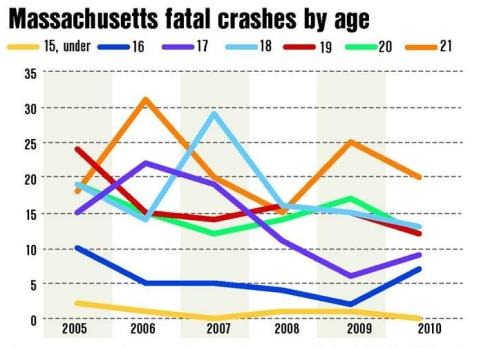This story from America makes interesting reading. It talks about how Massachusetts introduced a graduated licence system for young drivers back in 2007.
When the new law was introduced, it required that teenage drivers complete a mandatory 12 hours behind the wheel (increased from 6 – you have to remember that America has always had a different approach to learner drivers when compared with the UK, and allows learners to drive unsupervised), and 40 hours of logged accompanied driving with a parent or guardian. The accompanying driver had to complete a 2 hour course before they could supervise, and there were also restrictions placed on driving at night and driving with other teenagers in the car.
In fact, if you look up the full details, the overall requirements are more numerous (this is from Wikipedia):
Learner must complete driver’s education, hold their permit for six months incident free (no accidents, no citations, no warnings), and log 40 practice hours with a licensed driver over 21. Junior operators cannot drive between 12:30 a.m. and 5 a.m. unless accompanied by their parent or legal guardian and Massachusetts law provides no exceptions for employment, education, or medical reasons. Additionally, junior operators cannot drive with passengers under the age of 18 (except immediate family members) unless accompanied by a licensed driver over 21 within the first six months of obtaining a License. The Massachusetts JOL law also takes a zero-tolerance stance towards speeding, drivers under 18 caught speeding are subject to a mandatory 90 day suspension for the first offense accompanied by a mandatory road rage education class and a mandatory retake of the both permit and road tests. A one year revocation is mandatory for the second and each subsequent offense.
Reading the article I mentioned at the start would also seem to suggest that if a teenager violates certain of the conditions, then they basically go back to the start and have to begin the whole process again. So, in other words, it takes an effort to get a full licence (again, bear in mind that in America learners can drive unsupervised, so changes like this involve significant changes to people’s expectations and lifestyles).
However, the real eye opener is this graph, which shows the number of fatalities in the different learner age groups:
 The article states that in considering figures covering the period 1986 to 2007, there were 1,348 fewer fatal crashes involving 16-year olds after the new law was introduced, but 1,086 more for 18-year olds.
The article states that in considering figures covering the period 1986 to 2007, there were 1,348 fewer fatal crashes involving 16-year olds after the new law was introduced, but 1,086 more for 18-year olds.
That might lead you to conclude that the graduated licence hasn’t worked, but the article also points out that older teenagers aren’t completing driver education or gaining sufficient experience as solo drivers. It points out that the number of teens completing the driver education course has fallen by 20% since the law came into force. Some commentators also believe that the stringent requirements – such as the mandatory course that parents have to take – has also had an impact on take-up rates. One person says it is “a pain” to follow, even though it has had a very positive impact on teen deaths.
Mind you, America seems to have the same problem with driving instructors interfering with things that we do over here. You see, the article starts by quoting a learner driver (also a student) who is bemoaning the cost of learning to drive. She had to “get a job” to pay for it, and she wonders how those on low incomes manage.
Perhaps a driving licence is a right in America, not a privilege? I don’t know.
But the owner of the driving school she is learning with chimes in:
…the law’s impact on cost has been a hurdle for many teens and may be part of the reason they’re waiting until they’re 18 to get their license.
“The driving portion of driver education is about 95 percent of our cost,” he said. “The price has gone way up.”
Before the graduated license law, the 30 hours of classroom and six hours of behind-the-wheel training cost about $300 to $400, Mr. Gilmore said. Now, with double the behind-the-wheel time, it’s $600 to more than $900, depending on the auto school.
Mr. Gilmore said that 12 hours of behind-the-wheel time with an instructor may be unnecessarily high. “Most of the kids plateau in skill level at eight to 10 hours,” he said. “More kids would take driver’s ed if it was cheaper.”
I’ll mention again that the American way is different to ours, and their view is obviously going to be based on the premise of unsupervised driving being the norm. But why do instructors have to persistently try to put themselves across as philanthropists?
Just because someone can’t afford something doesn’t mean the price should be cut so they can. That’s only one step removed from allowing them to steal it!
But if the American driving instructors really do fancy their chances of a Carnegie Medal, perhaps they should look at dropping the price of their lessons. Because if increasing driving time from 6 to 12 hours has added over $500 to the overall cost, that must mean they’re charging close to $100 per hour (that’s nearly £65).
It doesn’t take a genius to realise that if something is working well – and the graduated licence system has slashed fatalities among teen drivers in this case – changing it to make it cheaper is going to screw it up.
More importantly, I wonder if such a system would work if it were introduced here? I don’t mean allowing unsupervised driving, but rigorous control of the learning process and restrictions on carrying passengers and night driving.
 The article states that in considering figures covering the period 1986 to 2007, there were 1,348 fewer fatal crashes involving 16-year olds after the new law was introduced, but 1,086 more for 18-year olds.
The article states that in considering figures covering the period 1986 to 2007, there were 1,348 fewer fatal crashes involving 16-year olds after the new law was introduced, but 1,086 more for 18-year olds. The
The  Well done Julian, who passed today first time with just 4 driver faults (he was quick to point out it was less than his sister, who passed first time with me with 9 driver faults just over a year ago). Both him and his sister were a pleasure to teach.
Well done Julian, who passed today first time with just 4 driver faults (he was quick to point out it was less than his sister, who passed first time with me with 9 driver faults just over a year ago). Both him and his sister were a pleasure to teach. In
In  Yep. Someone found the blog on precisely that search term.
Yep. Someone found the blog on precisely that search term. Well done Nancy, who passed today with 7 driver faults.
Well done Nancy, who passed today with 7 driver faults.

 I forgot to add this, but well done Jodie, who passed her test first time last Thursday with just 3 driver faults. That’s a really great result.
I forgot to add this, but well done Jodie, who passed her test first time last Thursday with just 3 driver faults. That’s a really great result.